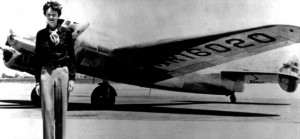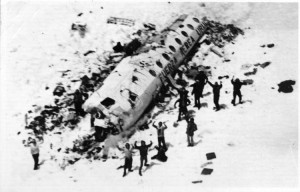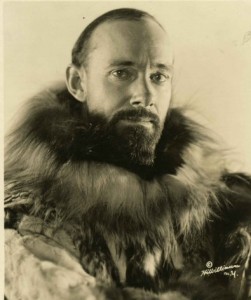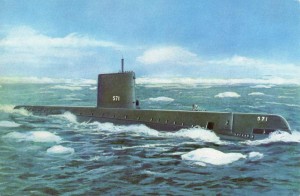Lost and Found in Psychic Space: Airplanes, Aviators, and ESP

I’m fascinated by how aviation and missing planes are so often linked, in one way or another, to ESP phenomena. The ongoing, frustrating search for Malaysian Flight 370 seems like the perfect opportunity to write down some thoughts about this strange nexus.
There’s a long history of psychics being enlisted (or volunteering) to search for lost planes, for one thing. One of the best-known successes of the early operational remote viewing work at Stanford Research Institute (SRI) was the successful location of a lost Soviet spy plane in the African jungle using the talents of viewers Gary Langford and Rosemary Smith. The annals of remote viewing (as described in Jim Schnabel’s excellent history of the subject) include other successful searches for missing aircraft. At Fort Meade for example, Ken Bell accurately pinpointed the site of a military crash in Virginia (even getting the name of the mountain, “Bald Knob”). On another occasion, he successfully remote-viewed the burned wreckage of an American helicopter that had crashed high in the Andes in Peru, killing the crew.
So it is to be expected that today’s most accomplished remote viewers and other psychics are being recruited to search for the missing Malaysian jet. Uri Geller, quite naturally, says he has been asked by a “substantial figure” for help in the search. Geller is more famous for telekinetic and telepathic feats than for clairvoyance, but he made his fortune map-dowsing for mineral and oil deposits—a skill one would think is not too different from viewing lost objects at a distance. He has not pointed to an actual location for the presumably downed plane, that we know of. But according to The Anomalist, remote viewer extraordinaire Joe McMoneagle, one of the original Fort Meade team, has also been tasked in the search; he says he has “duly reported” his findings.
 When scientific or military professionalism and rigor are not involved, psychic attempts to locate missing aircraft are, as one can imagine, often not only unsuccessful but even tragically misleading. In his thorough and riveting account
When scientific or military professionalism and rigor are not involved, psychic attempts to locate missing aircraft are, as one can imagine, often not only unsuccessful but even tragically misleading. In his thorough and riveting account of the Uruguayan rugby team lost in the Andes in 1972, Piers Paul Read documents the desperate families’ use of psychics to help in the search. A Belgian clairvoyant, Gerard Croiset Jr., was recruited, and although he described several specific details that ultimately proved accurate (such as a nearby sign reading “Danger” and the physical appearance of wreckage itself), he insisted the plane went down near a lake over 80 miles south of the crash site—resulting in much money, time, and effort being wasted searching in the wrong place.
The sad irony is that the first psychic consulted by parents of two of the lost boys, a dowser in a poor Montevideo neighborhood, turned out to have precisely pinpointed the location of the downed plane. Unfortunately the area he picked had already been overflown on early search flights and was, in any event, deemed too dangerous and remote for further searching. (Read’s book Alive contains more tantalizing ESP-related tidbits, including accurate premonitions of imminent rescue by some of the survivors; the more recent documentary Stranded includes survivors’ fascinating accounts of their near-death experiences during an avalanche that struck 16 days into their ordeal and killed 8 of their companions.)
Then of course there’s Amelia Earhart.
When Earhart went missing in her Lockheed Electra in 1937, her husband George Palmer Putnam was inundated with mail from psychics and others who insisted they knew where Earhart’s plane had gone down, had had dreams of her, or had actually communicated with her psychically in the days and weeks following the disappearance. A 1940 article in Popular Aviation, which has been made available as a pdf on the Earhart Project website, is a great read and another fascinating account of the paranormal giving hope to those desperate to find their loved ones but also hopelessly muddying the waters of an investigation of a lost flight.
 The Popular Aviation article only details a few of the examples of the messages Putnam received, unfortunately, but the ones described are particularly interesting in light of the unfolding (but lately stalled due to legal problems) efforts of the The International Group for Historic Aircraft Recovery (TIGHAR) to piece together Earhart’s last days and recover remains of the Electra. From what one can glean from the 1940 article, psychic consensus seemed to be that she and her navigator Fred Noonan went down somewhere north of Howland Island—not south, in the direction of Nikumaroro atoll, where TIGHAR has found tantalizing evidence that the flyers actually ended up. However, people who corresponded with Putnam said that they knew she had survived the crash and was on an island or atoll, and provided scenes that correspond to the picture being assembled by TIGHAR—that the famed aviatrix and her companion survived, possibly for a few weeks, before perishing (probably from dehydration).
The Popular Aviation article only details a few of the examples of the messages Putnam received, unfortunately, but the ones described are particularly interesting in light of the unfolding (but lately stalled due to legal problems) efforts of the The International Group for Historic Aircraft Recovery (TIGHAR) to piece together Earhart’s last days and recover remains of the Electra. From what one can glean from the 1940 article, psychic consensus seemed to be that she and her navigator Fred Noonan went down somewhere north of Howland Island—not south, in the direction of Nikumaroro atoll, where TIGHAR has found tantalizing evidence that the flyers actually ended up. However, people who corresponded with Putnam said that they knew she had survived the crash and was on an island or atoll, and provided scenes that correspond to the picture being assembled by TIGHAR—that the famed aviatrix and her companion survived, possibly for a few weeks, before perishing (probably from dehydration).
An interesting angle in this case is that Earhart herself was an accomplished psychic—although she publicly downplayed her talents in an era that was just as rationalistic and skeptical as ours. She had a particular knack for finding missing aircraft. As described by two newspaper columnists quoted by David K Bowman:
“Officials at first were inclined to laugh at Miss Earhart’s psychic messages. But her accuracy now has them mystified. When a United Airlines plane was lost just outside of Burbank, Calif. Dec. 27, Miss Earhart called the United Airlines office and told them to look on a hill near Saugus, a little town north of Burbank.
“There the wreckage was found.
“Again when the Western Air Express plane carrying Mr. and Mrs. Martin Johnson crashed Jan. 12, Miss Earhart reported the plane to be near Newhall, 15 miles north of Burbank, where it was found.
“In the earlier crash of the Western Air Express in Utah, Miss Earhart had a vision to the effect that the bodies of the dead had been robbed by a trapper. Two days later, a trapper near Salt Lake City reported finding the wreckage, but then suddenly disappeared without giving the location of the plane.”
There seems to be a link between a penchant for real-world flying and psychic aviation. For example, decades after his historic trans-Atlantic solo flight, Charles Lindbergh admitted in a memoir that during the 33-hour journey, during which he did not dare actually fall asleep, he experienced a hypnagogic, dissociative state in which he felt his body, soul, and spirit separate—what we might now call an out-of-body experience. During this experience, the flyer perceived and communicated with angelic beings accompanying him in his plane. The encounter left him with a lasting interest in the afterlife and immortality.
A more recent example is the popular author and aviator Richard Bach. After the CIA withdrew funding from the SRI project in the late 1970s (wanting to distance itself from questionable research in the aftermath of revelations about MK-ULTRA and other projects), Hal Puthoff and Russell Targ became increasingly creative in seeking support for their research at SRI. One person they sought out for possible help was Bach, whose bestseller Jonathan Livingston Seagull seemed (to Targ at least) like an account of an out-of-body experience—a phenomenon with strong continuity with remote viewing. On the hunch that Bach might be interested to participate in some psychic research himself and perhaps give some money to SRI, Targ and Puthoff invited Bach to California to take part in some experiments.
The writer proved quite talented. For example, in one out-bounder experiment described in Targ and Puthoff’s book Mind-Reach, he gave a very accurate physical description of the interior of a modern A-frame Methodist church and its altar—although in a case of “analytical overlay” biasing his interpretation, Bach thought the altar with the cross behind it looked like (appropriately enough) an airport ticket counter with a fleur-de-lis airline logo. Jacques Vallee, SRI Arpanet pioneer and friend to the remote viewing program, describes in his journals that he arranged to have a computer terminal installed in Bach’s Florida home, where Bach participated in a networked, cross-country remote viewing experiment in which he was remarkably accurate in describing an assortment of minerals chosen by a geologist.
The longest-distance psychic experiment ever conducted by an aviator, or anybody, is no-doubt that conducted by astronaut Dr. Edgar Mitchell aboard Apollo 14 in 1971. Like previous aviation pioneers, Mitchell had a profound mystical experience during his journey; but quite apart from this, he had a longstanding interest in ESP and, at four predetermined times during the mission, telepathically transmitted randomly selected Zener symbols (the type used in the classic Rhine experiments) to a small group of psychics back on Earth. He reported that there were 51 correct responses out of 200 total—slightly better than chance (there are 5 symbols in a Zener deck, so 40 correct responses would be predicted by chance). It is typical of the interesting but rather uninspiring positive results produced by classical psi research before the SRI era.
 The great precedent for Mitchell’s long-distance telepathy experiment, however, is far more inspiring. In 1938, a dashing, larger-than-life aviator and all-around hero explorer, Sir George Hubert Wilkins (left), volunteered on a dangerous mission to the arctic to search for a lost Russian plane and hopefully rescue the crew. Before he departed, he arranged to mentally send updates of his adventure at regular times each week to a New York writer with an interest in ESP named Harold M. Sherman. Sherman, for his part, recorded his impressions and had them notarized to prove that no cheating had transpired. Wilkins and Sherman documented the results in their classic book Thoughts Through Space
The great precedent for Mitchell’s long-distance telepathy experiment, however, is far more inspiring. In 1938, a dashing, larger-than-life aviator and all-around hero explorer, Sir George Hubert Wilkins (left), volunteered on a dangerous mission to the arctic to search for a lost Russian plane and hopefully rescue the crew. Before he departed, he arranged to mentally send updates of his adventure at regular times each week to a New York writer with an interest in ESP named Harold M. Sherman. Sherman, for his part, recorded his impressions and had them notarized to prove that no cheating had transpired. Wilkins and Sherman documented the results in their classic book Thoughts Through Space.
The records of Sherman’s and Wilkin’s experiment are remarkable, and resemble the sometimes astonishing accuracy of later CIA and military clairvoyants when real-world events and locales, rather than boring randomly generated cards, are involved. Reading the book through the lens of hindsight, it becomes clear—as it even became clear to the participants themselves when Sherman’s impressions were checked against Wilkins’ periodic bulletins—that “thoughts through space” did not accurately characterize the signal line through which Sherman received his information. Wilkins admitted he was often too busy, or simply forgot, to send his mental messages at the appointed times, but this did not prevent Sherman from obtaining detailed, usually accurate impressions of Wilkins’ activities and whereabouts.
In other words, Sherman was engaged precisely in remote viewing, not telepathy or (to use Upton Sinclair’s term) “mental radio.” Had it occurred to either of the experimenters to have Sherman psychically search for the missing Russian plane himself and thus serve as Wilkins’ guide rather than just his remote “receiver,” Wilkins’ mission may have been more successful than it was—but that would have required a paradigm shift in parapsychological thinking that was still over three decades off.
The experiment with Sherman is, to my knowledge, the first and last time Wilkins participated in an ESP experiment. Sherman, however, went on to write several interesting popular guides to developing ESP powers, not to mention numerous pulp sci-fi novels. In fact, he is a strangely absent figure in the nexus of psychic abilities, human potential, and sci-fi so densely chronicled by Jeffrey Kripal in his great book Mutants and Mystics.
In any case, there seems to be something fascinatingly archetypal about this nexus of aviation and ESP. Flying through air and space—and the extreme lengths to which one can get lost doing so—seem almost like a hieroglyph, in mundane 4-D reality, of how far one can travel and also get lost in the dimensionless space of consciousness and psychic abilities (or dis-abilities). Time will tell if and how this archetype plays out in the story of Flight 370. As The Anomalist notes, there may be little hope of anyone’s (even Geller’s or McMoneagle’s) ESP-derived insights having an impact on that search, given that there are bound to be hundreds or more intuitives, psychics, remote viewers, etc. giving their own conflicting reports. If I were one of the “authorities” involved, this is one reason I would be cautious following leads obtained from the paranormal information superhighway, however tantalizing they may be.
Postscript: Wilkins, The Nautilus, and SRI
Oddly enough, it is through an interesting mix of coincidence and distorted memory that Wilkins’ and Sherman’s Thoughts Through Space experiment may have had a decisive influence on the later research at SRI and the whole history of remote viewing.
According to Jim Schnabel, a 1960 report in the French magazine Science et Vie claimed that the nuclear submarine USS Nautilus had conducted a telepathy experiment on its historic voyage under the North Pole in 1958. Upon closer scrutiny, the claim proved to have been either fraudulent or based on fabricated information, but nevertheless it spurred anxiety on the part of the Soviets that the United States was developing psychic abilities for military application, and they began pouring money into paranormal research. It was this development, reported in Psychic Discoveries Behind the Iron Curtain in 1970, that in turn triggered anxiety in US intelligence and military circles that we may lose the psychic arms race if we didn’t fund such research ourselves. Hence SRI, and the subsequent developments at Ft Meade and elsewhere.
According to Schnabel, the source of the Science et Vie story that started the false rumor of US psychic research in the 1950s is unknown—it was either a hoax or may have been a deliberate disinformation ploy to get the Soviets to waste their money on paranormal woo. But I suspect the story could actually have arisen from a more innocent case of distorted recollection by someone involved in the magazine article or their sources, because it involves a fascinating, tangled knot of coincidences.
Several years before his 1938 arctic aviation expedition with its telepathy component, Wilkins had himself attempted to reach the North Pole underwater, in a decommissioned American submarine O-12 that he had leased from the Navy and rechristened, wait for it, The Nautilus. I think it would have been all too easy for someone to later conflate the various adventures of this dashing polar explorer (who sometimes engaged in telepathy experiments) with the news of the first actual polar crossing by a (this time nuclear) submarine, also named Nautilus, in 1958.
To make things more confusing, the nuclear Nautilus‘s first commander was named … Wilkinson.





I hope they are able to find the plane soon. I do not think a black hole sucked it in. That would mean the black hole would be too close to earth.